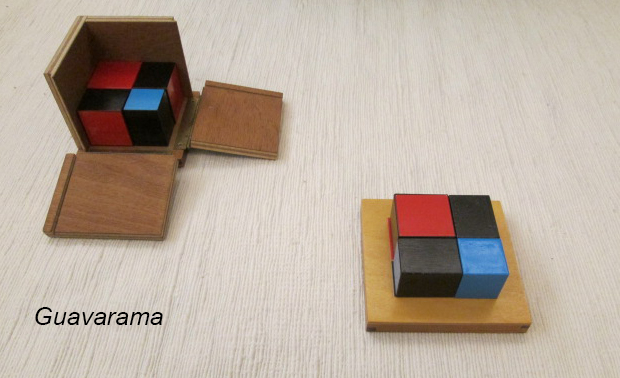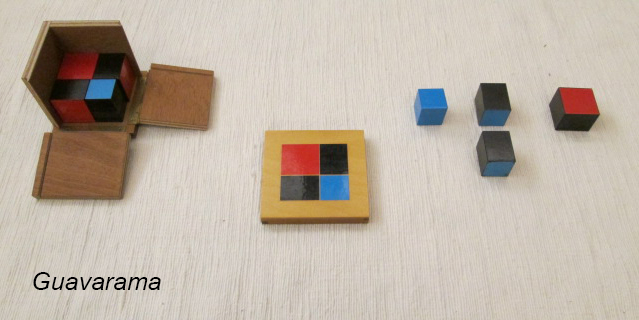 Earlier this week, Astroboy worked on the binomial cube.
Earlier this week, Astroboy worked on the binomial cube.
I’d tried to present this material to him before but he wasn’t interested. This time, it was just laying around on the mat because I had to take pictures for my class. Now he was interested. I feel like evidence is building that often kids are more interested in materials when it’s just laying around, enticing them, rather than when I choose a material to present to him. Not sure what this translates to when it comes to the classroom. Do I now need to really focus on making all materials enticing? (which is really hard when it comes to math, most of the materials are always covered!)
Binomial in Chinese
Since I’m focusing somewhat on Chinese, I think I’m going to research all Chinese names related to the materials. Bionomial cube is called 二項式正方體 in Chinese. Cube is 立方體. Another word for cube is 方塊. I think the first one is the math term and second one daily use. Other vocabulary you may have to use is 正方體 (square cube), 長方體 (rectangular cube). Though in our english presentation, we call it prism. I’m guessing (with only a little googling) it’s because we consider prisms as something that reflect light in Chinese?
The binomial cube in a primary classroom?
So what’s the binomial cube? It basically shows you the equation (1+2)^2 as a concrete material. In the primary classroom it’s part of the Sensorial Curriculum, things that cultivate your senses; in this case your visual sense. It’s NOT in the math curriculum.
But that is totally the brilliance of Montessori. The kids are going to see this again in Elementary when they learn squaring and cubing in earnest in 3rd-5th grade. And if they have attended a Montessori preschool, they would have been familiar with the material, in how to handle and construct them. And the kids don’t really know any different. It’s just blocks to them that you have to construct a certain way in order for it to fit back in the box. It’s a puzzle.
The cubes are color coded as a control of error: all red, all blue, blue-black, red-black. When your construct it, the same color should kiss each other. In Elementary, the red is labeled ‘a’, and the blue ‘b’. So a red cube is a^3, a red-black rectangle is a^2b. It all works.
What we did
I decided to change my presentation with Astroboy because he has not being doing follow up work and likes me to be there when he works. I suspected it is because I often let him participate as I present. Another consequence is that he doesn’t really pay attention while I present and misses the important points.

This time, I did a classic presentation. I sat the material on the mat, invited him to sit next to me, and we went through presentations. The first presentation is taking the cubes out and building it on the lid. The lid as a 2D rendering of the cubes, as a control of error. The second presentation, you build one layer on the lid, move it off, and build another on the lid. The third presentation, you categorize the blocks on the mat first, then rebuild on the lid. Astroboy kept saying “太簡單了 (It’s too easy)”. He didn’t want to work past the 2nd presentation.

However, two days later when he didn’t have anything else to do, I suggested to him again and he was willing to sit through the third presentation. It was still too easy for him (he says). My write up doesn’t have a 4th presentation, just extensions and variations. But I made up a fourth presentation by taking out all the cubes one by one and categorizing them (similar to 3rd presentation) and then rebuilding back on the lid. This is a bit harder because the height of each layer is actually different. So you actually need to look at your adjacent cubes to see which one to use.
Astroboy built it wrong the first time. The cubes will build themselves when a cube in layer one gets put on layer two. I really ought to have just let it be and show it to him again the next time. But instead, I ran my hand over one layer to show him it isn’t even. I least I didn’t say you’re wrong or talked. Then I showed it to him again, this time pointing to the colors in the adjacent cubes I swear, it is SO hard to not give in to your impulses when you teach at home. Anyways, he got it right the second time and then didn’t want to do it after that.
Would a teacher consider this as mastery? Typically if something is at the right difficulty level, a child will want to do it again and again. I could see it was pretty easy, he just needed to see the presentation twice. He need to be reminded you have to match the colors. Either that or it’s my failure when I showed him immediately how to do it “right”.
Here’s a video of Astroboy working with the material. I’m not sure which presentation, maybe a made up one I haven’t mentioned.
.
It always amazes me when I watch Astroboy actually working after a presentation. It is all him trying to make sure that the cubes line up properly. I was supposed to show that in my presentation but I forgot. Notice how he’s also doing it as quietly as possible, with smooth hand movements, the way he pulls out the cubes, and the fact that there is NO TALKING at all. Because he’s imitating my presentation.
Observations on Astroboy & Thumper
Astroboy as a child is so very different from Thumper. The two kids learn in very different ways. He has a very strong desire for order and is much more visual than his sister. This means that I can give him a very classic presentation, and he will very likely follow it to a T right after, especially if I do it slowly. He’s been like this since I showed him his first material at age 1.
If this was Thumper, and the material was kind of easy (as it was for Astroboy), then she would do it fairly quickly, not in as methodical and mindful way, and then immediately want to explore the material: see if it stacks some other way, make a game out of it, create her own cubes one day, or maybe draw it; creative stuff.
It took me till this year to accept this is the way Thumper learns, and I’m starting to see the advantage of it and know how to use her strength. In a way, I don’t have to worry about her. She will take a concept and run with it if she finds it interesting. For example, I can teach her about money, and rather than getting frustrated by the fact that she doesn’t want to do the work I show her, work that is often very methodical and orderly (boring in her eyes I think), if I let it be, she will come back and do things like making her own money, wanting to exchange money, playing money games.
I understand how Astroboy learn, who he is, but i’m actually at a loss right now as to how to work with it. Because often my suggestions for variations, or hands-on extensions are pooh-poohed. I’m not quite sure which WAY of working with a material entices him yet.
Why not just let them build?
If I were to make it harder, I could put the cubes in a distant location and have him retrieve them. If this was a traditional toy, you would dump it out, and the child would spend his time trying to figure out how to put it back in the box all by himself. This happened with Thumper because she played with the material while I was sleeping, when she was 3 or 4(?). She got really frustrated because she could not see how it worked and after trying a few times, gave up forever.
I used to be really confused and conflicted about the way materials are used in the Montessori classroom. Why do you show them how to work things out? Where is the joy in figuring out how to do things yourself? Children should be left to explore, to get it themselves, no? After a few years of classes, and just having the kids grow up, I see that either way kids will grow up and learn and I don’t need to get too obsessed over details so much, or as they say in Chinese 鑽牛角尖. I’ve also come to understand that Montessori is breaking down something into manageable, understandable, n+1 difficulty steps for the children, often with materials that adults think are above a child’s level. This is what any good teacher does. They observe and give children something right at their level.
More importantly, you can teach all you want, but the learning is up to the child. So the presentations cannot be viewed as a teacher teaching a child how to do something. It’s a teacher who shows a child how to manipulate the material, hopefully in a very engaging and “Wow, this is an interesting material!” kind of manner. Presentations are actually supposed to be mostly visual demonstration, with very few words/explanations and minimum gestures. The child often takes it and does something completely different with it and as long as they’re not breaking things it’s all okay.